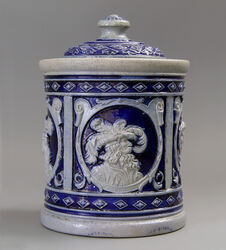Tobacco jar in historicizing style
January 2024

At the end of the nineteenth century we see a great revival in the production of stoneware in the historicizing style in Westerwald, Germany. We are pleased with this tobacco jar, which is a representative example of this fashion. It is a cylindrical pot with a flat lid that falls into a weighted lid edge. All around, between bands with nail heads, we see four large medallions with scroll work in the corners. Central to this are four portraits of alternately a man and a woman in thoroughly sixteenth-century clothing. They could have come straight out of a Dürer print. Particularly striking are the exuberant feathers on the hats of the two ladies. They are rich portraits, but the stylization in which they are executed turns them from historical almost to Art Nouveau. Westerwald stoneware is since the 16th century characterized by the gray shard covered with shiny salt glaze. Many pieces are decorated with cobalt, which provides cheerful blue accents. The manufacturer stamped his mark on the bottom, so we now know that this object was made by Eckhardt & Engler. This mark is often stamped as an intaglio along with the item's shape number, as in our case. In this way, the customer could easily reorder an article without any discussion about the implementation. As much as there is historicism, one adaptation is undeniably rooted in modern times. That is the possibility to place a sponge in the lid to keep the contents sufficiently moist. This is an important addition for a tobacco jar, especially when after 1900 the tobacco becomes more aromatic and needs to be moister during smoking. The large size says something about tobacco consumption at the time, nowadays a tobacco jar can easily be less than half this size.
Amsterdam Pipe Museum APM 24.701
Permalink